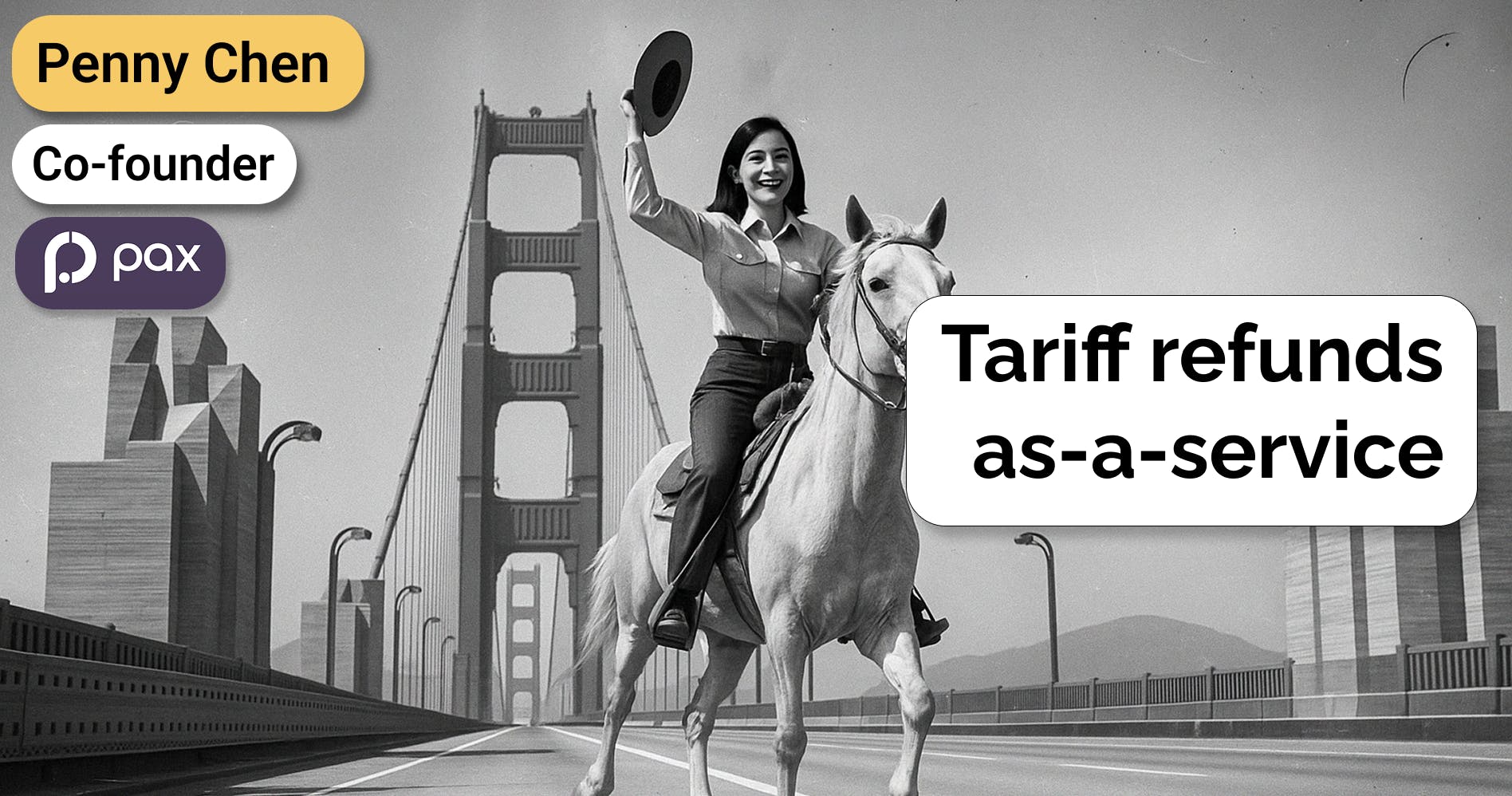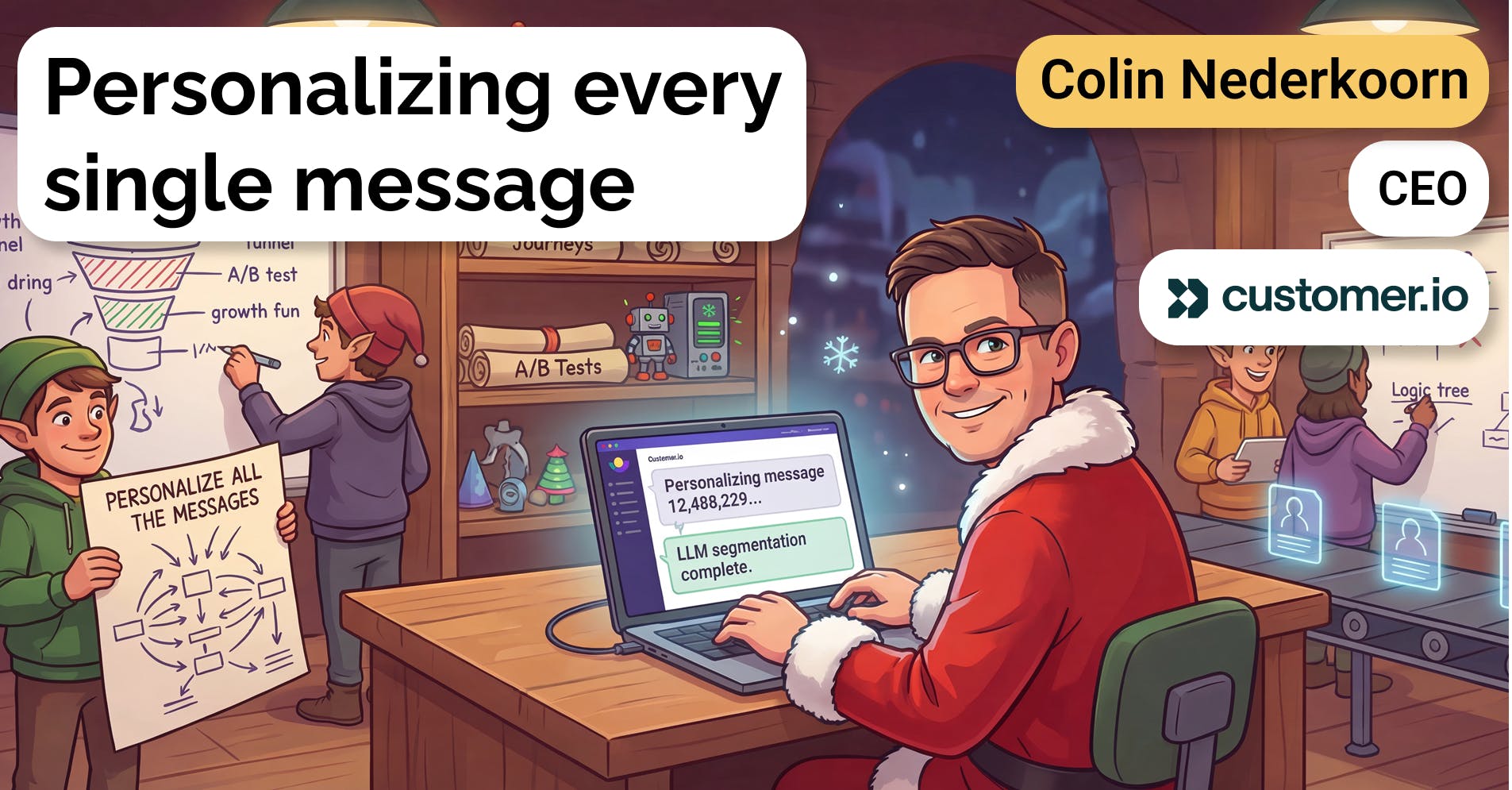Penny Chen, CEO of Pax, on building AI-powered tariff refunds
 Jan-Erik Asplund
Jan-Erik Asplund

Background
Trump’s 2025 tariff package—10% across the board, up to 145% on Chinese goods—has made importing finished products massively more expensive. But a 200-year-old trade program, designed to avoid penalizing U.S.-based exporters, offers a critical release valve: under the duty drawback system, companies that re-export or manufacture for export can recover up to 99% of the duties they paid.
We spoke with Pax CEO Penny Chen about the increasing importance of duty drawback—and how AI is making it newly accessible to SMBs.
Key points from our conversation via Sacra AI:
- With tariffs increasing in both size and scope, duty payments—typically due within 10 days of entry—create not just margin pressure but working capital drag, with landed costs front loaded on entry and any duty drawback refund arriving months later. “Duty drawback says that if you import and then re-export, manufacture, or have other eligible activities, the government will give you up to 99% of the import duty or tariff refunded... whenever [companies] submit a claim, they receive cash after about 3–6 weeks… Traditional service providers take nine to twelve months, which is a long lead time with many manual processes involved, making it time-consuming and costly.”
- Re/nearshoring has the potential to explode the complexity of tariff compliance and duty drawback as companies shift from importing finished goods to sourcing a fragmented web of components from across global trade zones—each with distinct HTS codes, tariff treatments, and refund implications. "The most challenging thing is ensuring imports are compliant. Whenever you import, you need to tell the government what you're importing, which includes HTS code classification - classifying your goods to a code so the government knows what to charge you, as duty rates are based on the code and country of origin... Licensed customs brokers are struggling to keep up with the new changes.”
- In a market historically centered around legacy, enterprise providers like Charter Brokerage, AI-native startups like Pax and tech-forward logistics leaders like Flexport have the potential to expand duty drawback across Fortune 500 through SMB by using large language models (LLMs) to automate the structuring of unstandardized customs & business records—bills of lading, invoices, HTS classifications—to dramatically speed up & lower the cost of calculating a claim. "Currently, only enterprise companies use drawback because if your refund amount is too small, service providers won't take you on. It wouldn't make sense for them to process a claim for nine to twelve months and only earn, for example, $100K… For Pax, the process has the same inputs and outputs - we're still getting unstructured data and still submitting claims to the government - but our process is very different. We automate extensively with AI and software to lower the cost to serve, enabling us to work with companies of all sizes.”
For more, check out this other research from our platform:
- Flexport (dataset)
- Flexport at $3.3B revenue
- Sean Frank, CEO of Ridge, on the state of ecommerce post-COVID
- Shein vs Trump
- Shipbob (dataset)
- Klaviyo: the $665M/year HubSpot for ecommerce
- Tyler Scriven, CEO of Saltbox, on co-warehousing and D2C ecommerce
- Brian Whalley, Co-Founder of Wonderment, on Klaviyo's product-market fit
Questions
- It'd be great to sort of get the simple explanation of what duty drawback is but then also given that every kind of tax or tariff scheme is about incentives in some way, what kind of incentive structure is it meant to create or designed to create?
- What does it look like for a retailer or manufacturer to actually claim duty drawback?
- How does this work at the legacy players? Presumably, there's some kind of overseas team of people who parse data and then maybe a large team of CPAs who are sort of tasked with putting together the refunds.
- What do tariffs mean for Pax's business? Is it both a tailwind and headwind because more tariffs means more potential for refunds, but there's also the potential for certain industries and certain kinds of companies doing less international trade?
- I'm curious for your take on nearshoring and if you see certain industries that are more able to do that or more serious about doing it. If nearshoring happens, is that more a threat or opportunity for Pax?
- We've covered Shein and Temu and other de minimis utilizing companies a few times. How do you see de minimis playing out against this tariff landscape? Do you see this driving higher demand from ecommerce shippers, whether big or small?
- There's this dynamic where a lot of legal/tax SaaS is valuable because it help you sells and manage your sales tax across all these different local jurisdictions where laws are different. Is that kind of dynamic relevant for Pax or is it all being driven by US policy right now?
- Who is the core customer of Pax?
- Who is the core user of Pax inside the firm, and how do they use it, and what's the frequency? Is this a quarterly reporting aspect or is it annual? How does that work?
- So they basically just send over their documents, share all their documents, and then you do it all for them. Is it a yearly sort of process?
- Was it possible to sort of build what you guys have pre-LLM and maybe pre-NLP, and where is AI most useful? Where does it fall short still to this point?
- Is there anything you can share about what your AI tool stack looks like? Are you using any fine-tuned models or your own models, or OpenAI, Anthropic? Where do you land on that?
- What's the sort of upside you see given that AI models are getting a lot better very quickly? Are there other parts of the process that you can see better AI models automating more, or not?
- It’d be great to get your big picture vision of how you see supply chains evolving in the years to come. And what role does duty drawback sort of play in that change?
- If everything goes right for Pax, if everything goes well, what do you see Pax being at that point and how do you see this broader customs brokerage ecosystem around you?
Interview
It'd be great to sort of get the simple explanation of what duty drawback is but then also given that every kind of tax or tariff scheme is about incentives in some way, what kind of incentive structure is it meant to create or designed to create?
Duty drawback is an import duty or tariff refund program. Many countries have it, but the US has the largest duty drawback program. To give you a sense of the numbers, each year there's about $100 billion in import duty and tariff paid annually, with about $4 billion being refunded through the duty drawback program.
To zoom in on the business impact: when you import to the US, you pay import duty and tariffs. The rates range widely, but typically run 5-10%. For imports from high-duty countries like China, there are additional tariffs such as Section 301, which imposes an additional 25% duty rate on top of the regular duty rate.
So if you're shipping a $100 item, you might pay $35 in duty because you have the baseline duty plus the Section 301 duty. This is a nontrivial amount that companies are paying.
Duty drawback says that if you import and then re-export, manufacture, or have other eligible activities, the government will give you up to 99% of the import duty or tariff refunded. In the example of a $100 good with $35 in duties and tariffs, if you later re-export that good, you can get 99% of that $35 back.
There are two main types of duty drawback users: retailers and manufacturers. For manufacturers, the typical use case is importing parts and components to the US and paying tariffs on those parts. They then use these parts to manufacture goods within the US, and when they ship out the finished goods, all the import duty paid on the parts can be refunded up to 99%. The US government wants to encourage manufacturing in the US, so that's one motivation for the drawback program.
The other main users are retailers. For them, it's usually because they do inventory rebalancing and reshuffling. They import goods to the US, pay duty on them, but never actually use or sell them. Then they re-export to nearby countries like Canada, Mexico, or sometimes Europe. When companies like Nike or Lululemon re-export these goods, the import duty they paid can be refunded up to 99%.
For retailers and manufacturers with high-volume import-export activity, duty drawback is essentially an essential program to improve their bottom line.
What does it look like for a retailer or manufacturer to actually claim duty drawback?
I'll talk about the traditional process first, then how Pax does it.
Today, if you want to get a refund, you go to traditional duty drawback service providers. These providers operate very manually. They collect your import records, export records, with all the line-level detail of imports - goods value, dates, HTS codes, and the same for exports.
These data usually exist in unstructured formats: bill of lading, commercial invoice, PDF, CSV, or ERP systems. The service providers collect this data and go through Excel-based manual entries to get it into a structured format. Then they work out the refund calculation either manually through Excel or through a software called DutyCalc that 90% of drawback service providers use, which is literally a Windows 98 application.
People are doing this very inefficiently. Typically, it takes these service providers months or even years to process a claim - usually nine to twelve months. That's a long lead time with many manual processes involved, making it time-consuming and costly.
Currently, only enterprise companies use drawback because if your refund amount is too small, service providers won't take you on. It wouldn't make sense for them to process a claim for nine to twelve months and only earn, for example, $100K. Typically, if your refund amount is under $100K, most traditional providers won’t prioritize or accept your claim. That's why only large enterprises are doing drawback today.
For Pax, the process has the same inputs and outputs - we're still getting unstructured data and still submitting claims to the government - but our process is very different. We automate extensively with AI and software to lower the cost to serve, enabling us to work with companies of all sizes.
I want to highlight two key improvements. First, in data collection, if your data is unstructured, we use AI to parse it and automatically join and merge it. We typically save 99% of the processing time compared to manual methods.
Second, in claim calculation, duty drawback is actually a nontrivial math problem. It involves matching import records to export records, applying different regulations and accounting methods to identify feasible matches, and then picking the matches that maximize your refund. If you have millions of imports and exports, it's computationally intensive to evaluate all possible combinations and select the matches that maximize your refund.
Traditional service providers simply cannot do this - they can't offer you the optimal refund because it's impossible for them to iterate through all combinations. At Pax, my background is in algorithm design - I completed my PhD from MIT in 2022 and was previously a research scientist at Amazon. We've built proprietary algorithms that guarantee maximum outcomes while performing calculations automatically without manual intervention. Pax not only provides the maximized refund (typically 15% more on average compared to industry-leading software), but everything is done automatically.
How does this work at the legacy players? Presumably, there's some kind of overseas team of people who parse data and then maybe a large team of CPAs who are sort of tasked with putting together the refunds.
They're called duty drawback analysts or duty drawback experts. All they do is get the data, parse it, structure it, and do some manual simple algorithmic exercises to arrive at the right numbers for the calculation.
Companies like KPMG and PwC, the larger accounting firms, offer drawback as a service. But they're not the largest players. The largest drawback service providers are brokers that specialize in drawbacks. For example, Charter Brokerage is the largest duty drawback service provider today. Each year, they process about $1 billion in refunds and have 30% of the market share. They were acquired by Berkshire Hathaway back in 2014 for $500 million.
What do tariffs mean for Pax's business? Is it both a tailwind and headwind because more tariffs means more potential for refunds, but there's also the potential for certain industries and certain kinds of companies doing less international trade?
Very good question. Initially, when the reciprocal tariffs and these additional tariffs were announced, we were nervous because we didn't know if they would be eligible for duty drawback. Until last Friday, when CBP announced that reciprocal tariffs will be eligible for drawback, which was a huge relief for us.
This will expand the duty drawback market significantly, though by how much depends on the actual import volume and final duty percentages, which keep changing. Since they're eligible, it will definitely expand the market unless import-export volume drops dramatically. If tariff rates become extreme, people might not want to import or export, which could hurt the market if total volume declines.
Generally, this is a huge win for the drawback community. I saw an article saying that these additional tariffs could represent up to $486 billion. So at most, the market could grow up to six times its current size, assuming volumes stay constant, which is a huge assumption. But in general, these tariffs are unprecedented.
Because of these additional tariffs, people are becoming more aware of duty-saving strategies. This week alone, we've received many inbound inquiries, and our website and LinkedIn have seen abnormal traffic peaks because of the recent tariff news.
I'm curious for your take on nearshoring and if you see certain industries that are more able to do that or more serious about doing it. If nearshoring happens, is that more a threat or opportunity for Pax?
I think bringing activities back to America will generally be beneficial for Pax and duty drawback because there will be more imports coming into the country. People will be paying more tariffs.
For companies, supply chains are complicated. When considering bringing things into the US, they need to ensure not just that labor and supply chain costs make sense, but also their strategy on tariffs. Today, there are two major duty/tariff saving strategies: duty drawback and foreign trade zones. It's very important for companies to look into these two strategies before making decisions.
We've covered Shein and Temu and other de minimis utilizing companies a few times. How do you see de minimis playing out against this tariff landscape? Do you see this driving higher demand from ecommerce shippers, whether big or small?
In general, de minimis has ensured that companies like Shein and Temu can offer competitive prices because they're not paying import duty and tariffs like other importers do. If de minimis goes away, they will start paying tariffs and duties, and their prices will rise. Given the new announcements, the tariff would now effectively total 145% on goods, so prices would definitely increase at least that much.
If they're only doing domestic sales - importing and selling in the US - there's no way they can get that money back. But if there are returns, duty drawback has a provision for returns too. If they import items, never sell them, and then return them, those can also be eligible for duty drawback. So duty drawback could potentially play a role in saving some inventory costs for returned goods.
There's this dynamic where a lot of legal/tax SaaS is valuable because it help you sells and manage your sales tax across all these different local jurisdictions where laws are different. Is that kind of dynamic relevant for Pax or is it all being driven by US policy right now?
Whenever regulations change, tax software needs to update because calculations must accommodate the most updated regulations for compliant claims. That's a challenge for software companies. But compared to humans trying to keep up with changing regulations, software still has an advantage with quicker updates. We constantly monitor regulatory changes and reflect them in our software in real time, which is actually a competitive advantage when we go to market.
I should also point out that duty drawback laws have been relatively static compared to other regulations and financial applications. The changes aren't as drastic, so we're able to keep up with them.
Who is the core customer of Pax?
Very good question. Pax's core competence today is our software - we minimize processing time and maximize refunds. There are a few types of customers:
One major type is existing duty drawback service providers who want a better tool to process their claims.
Another type is brokers or service providers to importers/exporters who don't know about drawback or how to offer it as a service. Pax helps them offer duty drawback as a service to their clients. These are our channel or referral partners. For these customers, Pax not only offers software but also our drawback expertise to handle the drawback process end-to-end.
We rarely work directly with importers/exporters because the acquisition rate isn't very high. However, the advantage of working directly with them is they can come to us and get wholesale pricing because there's no intermediary.
The most challenging thing for those folks is ensuring imports are compliant. Whenever you import, you need to tell the government what you're importing, which includes HTS code classification - classifying your goods to a code so the government knows what to charge you, as duty rates are based on the code and country of origin.
I just came back from a trade compliance conference where licensed customs brokers are struggling to keep up with the new changes. All these changes affect tariff rates and code usage, with new codes being introduced. It's very challenging for people to stay current.
Volume-wise, most activity remains relatively stable because rerouting your supply chain doesn't happen overnight. But if tariffs go up significantly, volume might drop and businesses could stagnate.
Who is the core user of Pax inside the firm, and how do they use it, and what's the frequency? Is this a quarterly reporting aspect or is it annual? How does that work?
We built our software around the customer, based on their level of expertise and the amount of work they want to take on. For example, with a referral partnership, we provide a dashboard that shows all the claims we process with their customer. They have view-only access to everything we do - they can see the data, the claims, and analytics. All they do is refer customers to our platform, and we handle everything.
For more technical users, like drawback experts already doing drawback, we provide software they use to calculate claims. They use it to upload data, massage data, filter data, select the right provisions for calculation, manage data residuals in the system, and submit claims electronically to the government. We're an ABI-certified software from CBP, so we can electronically submit claims from our software directly to CBP.
So they basically just send over their documents, share all their documents, and then you do it all for them. Is it a yearly sort of process?
Our turnaround is very quick, usually less than a month, though it depends on the user type. For first-time filers, they need to submit an application to the government (called a privilege application) before they can submit claims. Without government approval of this application, you cannot submit a claim, and that approval typically takes 2-6 months. Usually, Pax will finish preparing your claim well before the application is approved, so you're ready to submit upon approval.
For repeat filers who are already approved, the process is very quick. Whenever they submit a claim, they receive cash after about 3-6 weeks. We prioritize these customers over first-time filers because of the quicker turnaround. For them, it's typically a three-month process from getting the data to claim submission.
Was it possible to sort of build what you guys have pre-LLM and maybe pre-NLP, and where is AI most useful? Where does it fall short still to this point?
There are several ways we use AI or algorithms. First, duty drawback calculation is a deterministic problem. You cannot rely on a black-box AI where you can't predict the accuracy of results. For the calculation piece, we use deterministic optimization algorithms based on regulations, with zero error tolerance.
The other piece is data ingestion. When extracting information from PDFs, that's where we use LLMs, where some error tolerance is acceptable. We use LLMs to get the data, then have an internal review process - a human-in-the-loop approach where extraction results are manually reviewed and approved before entering the database.
Pre-LLM, we wouldn't have been able to do the extraction part so efficiently.
Another example I can share is the privilege application I mentioned. When starting to do claims, you need to submit a document to the government that includes details like manufacturing processes. These typically take time for humans to write properly. We use LLMs here too, with a chatbot where users interact and provide basic information about their supply chain, and we draft the application or manufacturing ruling for them to review rather than writing it from scratch.
In general, we're very careful about LLMs because we operate in a highly regulated space. We only use them where there's error tolerance or where a manual review process exists.
Is there anything you can share about what your AI tool stack looks like? Are you using any fine-tuned models or your own models, or OpenAI, Anthropic? Where do you land on that?
We've tried both OpenAI and Anthropic. We don't fine-tune our models - we mostly use prompt engineering with some adjustments. It's a relatively straightforward use case for us.
What's the sort of upside you see given that AI models are getting a lot better very quickly? Are there other parts of the process that you can see better AI models automating more, or not?
The data we collect is very unstructured. People have different naming conventions for the same information - for example, "import date" might be called "import date" or "import-date" or something else. A lot of these discrepancies can be easily structured by AI. As models improve, these inconsistencies can increasingly be structured before human intervention. That's a huge win - as models improve, our system is built to improve alongside them.
Our model implementation is mostly plug-and-play, so we don't have to rely on specific models. As models improve, we can select the one that best fits our use case and performs best, without redesigning our whole structure. We're not fine-tuning any specific models.
It’d be great to get your big picture vision of how you see supply chains evolving in the years to come. And what role does duty drawback sort of play in that change?
It's hard to predict, but duty drawback will likely continue because governments worldwide want to encourage imports and exports. The more we can optimize the process and lower barriers for companies of all sizes, the better we can stimulate our economy positively.
Right now, drawback is a privileged tool primarily for large enterprises. By lowering barriers, we help SMBs and enrich the ecosystem by enabling more competitive players. Pax is trying to lower that barrier so all companies have the same competitive advantage in terms of getting refunds.
If everything goes right for Pax, if everything goes well, what do you see Pax being at that point and how do you see this broader customs brokerage ecosystem around you?
Pax focuses on duty drawback, but there are many inefficiencies in global trade - in money transactions, compliance, and other areas that are done manually and inefficiently. As we increase our customer base and understand them better, Pax can offer more surrounding services.
In general, regardless of who's president, we all want global trade to be as efficient as possible. We want Pax to play an important role in that future.
Disclaimers
This transcript is for information purposes only and does not constitute advice of any type or trade recommendation and should not form the basis of any investment decision. Sacra accepts no liability for the transcript or for any errors, omissions or inaccuracies in respect of it. The views of the experts expressed in the transcript are those of the experts and they are not endorsed by, nor do they represent the opinion of Sacra. Sacra reserves all copyright, intellectual property rights in the transcript. Any modification, copying, displaying, distributing, transmitting, publishing, licensing, creating derivative works from, or selling any transcript is strictly prohibited.







